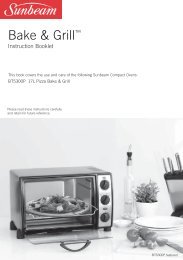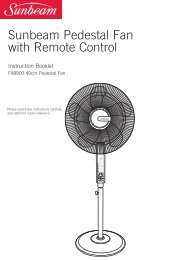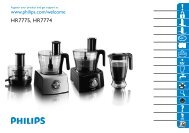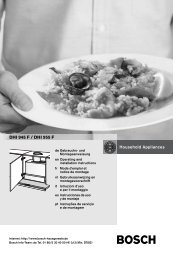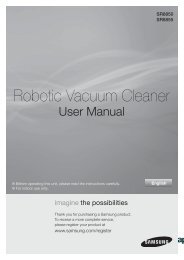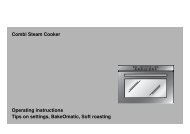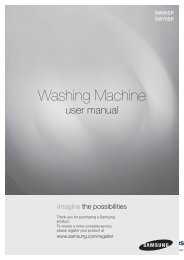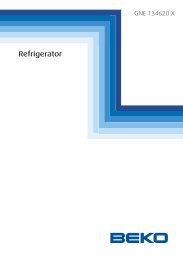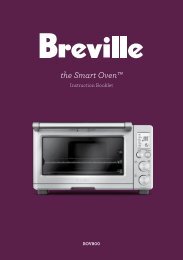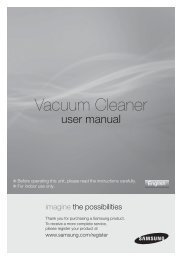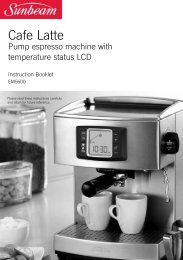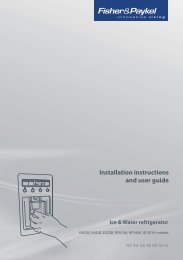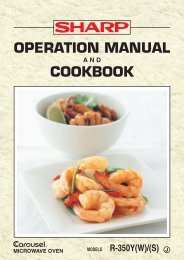Refrigeration - Appliances Online
Refrigeration - Appliances Online
Refrigeration - Appliances Online
You also want an ePaper? Increase the reach of your titles
YUMPU automatically turns print PDFs into web optimized ePapers that Google loves.
<strong>Refrigeration</strong><br />
Use & Care
Congratulations<br />
Congratulations and thank you for choosing our refrigerator.<br />
We are sure you will find your new refrigerator a pleasure<br />
to use. Before you use the refrigerator, we recommend that<br />
you read through the entire user manual, which provides<br />
the description of the refrigerator and its functions.<br />
To avoid the risks that are always present when you use<br />
an electric appliance, it is important that the refrigerator is<br />
installed correctly and that you read the safety instructions<br />
carefully to avoid misuse and hazards.<br />
We recommend that you keep this instruction booklet<br />
for future reference and pass it on to any future owners.<br />
After unpacking the refrigerator please check it is not<br />
damaged. If in doubt, do not use the refrigerator but<br />
contact your local Electrolux Customer Care Centre.<br />
environmental tip<br />
Information on disposal for users<br />
• Most of the packing materials are recyclable.<br />
Please dispose of those materials through your<br />
local recycling depot or by placing them in<br />
appropriate collection containers.<br />
• If you wish to discard this refrigerator, please<br />
contact your local authorities and ask for the<br />
correct method of disposal.<br />
Kelvinator quick start guide<br />
1. Ensure appliance is on a flat surface.<br />
2. Leave standing in stable upright position<br />
for half an hour prior to turning ‘on’.<br />
3. Plug into power socket and turn on.<br />
4. Temperature controls are pre-set to ‘mid’<br />
adjust as required.<br />
5. Leave run for 2 – 3 hours before storing food.<br />
For optimum usage, safety information and<br />
handy hints please read full document.<br />
2 Contents Kelvinator <strong>Refrigeration</strong><br />
Contents<br />
Important safety instructions 3<br />
Installing your new refrigerator 4<br />
Side by Side model features 6<br />
Top and Bottom Mount model features 7<br />
Refrigerator & freezer operation 8<br />
Controlling the temperature 8<br />
Using your refrigerator 10<br />
Changing the light bulb 10<br />
Cleaning your refrigerator 11<br />
Energy consumption 12<br />
Safety 12<br />
Helpful hints 13<br />
Troubleshooting 14<br />
Warranty 15<br />
Conditions of use<br />
This appliance is intended to be used in household<br />
and similar applications such as:<br />
• Staff kitchen areas in shops, offices and other<br />
working environments<br />
• Farm Houses<br />
• By clients in hotels, motels, and other residential<br />
type environments<br />
• Bed and Breakfast type environments<br />
• Catering and similar non-retail applications<br />
warning<br />
R600a refrigerant warning<br />
This appliance contains a small quantity of<br />
environmentally friendly, but flammable, non-synthetic<br />
R600a refrigerant. It does not damage the ozone<br />
layer. Avoid safety hazards by carefully installing,<br />
handling, servicing and disposing of this appliance.<br />
If your appliance contains R600a refrigerant it will be<br />
indicated on the rating plate inside the appliance:<br />
• Ensure that the tubing of the refrigerant circuit is not<br />
damaged during transportation and installation.<br />
• Leaking refrigerant may cause eye injuries or ignite.<br />
• The room for installing appliance must be at least<br />
1m3 per 8g of refrigerant. The amount of refrigerant<br />
in the appliance can be found on the rating plate<br />
inside the appliance.<br />
• If you are unsure of the refrigerant check the rating<br />
plate inside the refrigerator compartment.<br />
• It is hazardous for anyone other than an Authorised<br />
Service Person to service this appliance. In<br />
Queensland Australia the Authorised Service Person<br />
MUST hold a Gas Work Authorisation for hydrocarbon<br />
refrigerants to carry out servicing or repairs which<br />
involve the removal of covers.
Important safety instructions<br />
Please read the user manual carefully and store in a handy<br />
place for later reference.<br />
The symbols you will see in this booklet have these meanings:<br />
warning<br />
This symbol indicates information concerning your<br />
personal safety<br />
caution<br />
This symbol indicates information on how to avoid<br />
damaging the appliance<br />
tips and information<br />
This symbol indicates tips and information about<br />
use of the appliance<br />
environmental tip<br />
This symbol indicates tips and information about<br />
economical and ecological use of the appliance<br />
Meanings of symbols used in this manual are shown below:<br />
This symbol indicates never to do this<br />
This symbol indicates always do this<br />
warning<br />
• If pressurised aerosol containers bear the<br />
word ‘flammable’ and/or a small flame<br />
symbol, do not store them inside any<br />
refrigerator or freezer. If you do so you<br />
may cause an explosion.<br />
• This appliance is not intended for use by persons<br />
(including children) with reduced physical, sensory<br />
or mental capabilities, or lack of experience and<br />
knowledge, unless they have been given supervision<br />
or instruction concerning use of the appliance by<br />
a person responsible for their safety.<br />
• Children should be supervised to ensure that they<br />
do not play with the appliance.<br />
• When you dispose of your old refrigerators and<br />
freezers, remove any doors. Children can suffocate<br />
if they get trapped inside.<br />
• This appliance contains insulation formed with<br />
flammable blowing gases. Avoid safety hazards<br />
by carefully disposing of this appliance.<br />
warning<br />
The appliance must be plugged into its own<br />
dedicated 220-240V, 50Hz AC electrical outlet.<br />
Ensure that the electric outlet is properly earthed<br />
to ground. Consult a qualified electrician if you<br />
are unsure.<br />
The plug must be accessible when the<br />
appliance is in position.<br />
Do not use an extension cord or adapter plug.<br />
If the power cord is damaged, it should<br />
be replaced by a service technician or<br />
a qualified person.<br />
Unplug the appliance before cleaning and<br />
before changing the light bulb to avoid<br />
electric shock.<br />
Never unplug the appliance by pulling on the<br />
power cord. Always grip the plug firmly, and<br />
pull straight out of the receptacle to prevent<br />
damaging the power cord.<br />
Choose a location that is not too cold –<br />
the temperature should be above 10°C.<br />
Put the appliance in a dry place, avoiding areas<br />
of high moisture or humidity.<br />
Don’t put the appliance in frosty or unprotected<br />
areas, for example in a garage or on a verandah.<br />
Don’t put the appliance in direct sunlight.<br />
Don’t put the appliance near stoves, fires<br />
or heaters.<br />
Do not use mechanical devices or other means<br />
to accelerate the defrosting process, other than<br />
those recommended by the manufacturer.<br />
Do not damage the refrigerant circuit.<br />
Do not use electrical appliances inside the<br />
food storage compartments of the appliance,<br />
unless they are of the type recommended by<br />
the manufacturer.<br />
When correctly installed, your appliance should:<br />
• have adequate clearance to the back and sides<br />
for air circulation (refer to page 4).<br />
• be aligned to the surrounding cupboards.<br />
• have doors that will self-close from a partially<br />
open position.<br />
warning<br />
• Have the stability foot in place (see diagrams on<br />
pages 4 and 5) to prevent the appliance falling<br />
forward when a door with heavy food load is opened.<br />
Kelvinator <strong>Refrigeration</strong> Important safety instructions 3
Installing your new refrigerator<br />
Clearance around your Side by Side refrigerator<br />
Your Side by Side Refrigerator can be installed between<br />
cupboards or fixtures but you must allow for the following<br />
spaces around the cabinet.<br />
1. allow a minimum of 5mm clearance on both sides.<br />
2. allow 10mm clearance at the back of the refrigerator.<br />
3. allow a minimum of 10mm clearance above hinge covers.<br />
4. allow a 250 or 350mm DOORS clearance on the hinge side of<br />
the doors, if you place the refrigerator next to the wall.<br />
This will make cleaning easier.<br />
5. make sure that cupboards or fixtures do not stick out<br />
further than the refrigerator cabinet.<br />
Clearance around your Top and Bottom Mount refrigerator<br />
1. allow a minimum of 5mm clearance on both sides.<br />
2. allow 10mm clearance at the back of the refrigerator.<br />
3. allow a minimum of 10mm clearance above hinge covers.<br />
4. If you do not have a cupboard with a rear gap, the<br />
recommended clearance area on top increases from<br />
50mm to 90mm.<br />
5. When positioned in a corner area, spacing of at least<br />
350mm on the hinge side will allow the doors to open<br />
enough to enable the removal of bins and shelves.<br />
30mm<br />
50mm<br />
Recommended<br />
airspace<br />
CABINET<br />
DOOR<br />
5mm<br />
5mm<br />
250mm<br />
250mm<br />
30mm<br />
10mm<br />
Recommended<br />
airspace 10mm<br />
CABINET<br />
Recommended<br />
DOORS<br />
airspace<br />
CABINET<br />
Freezer<br />
Door<br />
Freezer<br />
Door<br />
5mm<br />
5mm<br />
90mm<br />
10mm 35mm<br />
10mm 35mm<br />
Fridge<br />
Door<br />
Fridge<br />
Door<br />
Note: Doors on all models are designed to sit proud of<br />
cabinetry (not flush). The refrigerator should be placed<br />
against a wall and the gap between the rear of the<br />
refrigerator and the wall should be no greater than 75mm.<br />
4 Installing your new refrigerator Kelvinator <strong>Refrigeration</strong><br />
350mm<br />
350mm<br />
350mm<br />
Installing your refrigerator<br />
The appliance should arrive with the<br />
front adjustable rollers wound down to<br />
tilt the top of the refrigerator backwards<br />
by about 10 -15mm from upright.<br />
The stability foot should also be wound<br />
fully up so it will not interfere with the<br />
operation of the rollers (see diagram<br />
in Step 3 below).<br />
caution<br />
Height adjustable<br />
front rollers<br />
The rollers are designed for forward or backward<br />
movement only. They are not castors. Moving the<br />
refrigerator sideways may damage your floor and<br />
the rollers.<br />
1. Roll the refrigerator into its final position.<br />
10-15mm<br />
2. The top of the refrigerator should be tilted back by<br />
approximately 10 -15mm. This will allow the doors to<br />
self-close providing a consistent door seal.<br />
Fixed rear<br />
rollers<br />
3. If the refrigerator is not tilted back, you can adjust the<br />
two front rollers by turning the large, plastic roller nut<br />
(see diagram below). This will increase the height of the<br />
rollers. One turn of the nut will tilt the refrigerator back<br />
approximately 10mm. If you have difficulty turning the<br />
roller nut you can have someone tilt the refrigerator back,<br />
so that you have better access. Alternatively, you can<br />
access the rollers from the side, using a flat screwdriver<br />
to help you turn the nut (see diagram below).<br />
Stability foot<br />
wound up<br />
4. Check the alignment of the refrigerator to the<br />
surrounding cupboards. The top of the refrigerator<br />
should be level from side to side (see diagram below).<br />
If you need to adjust the level, use the adjustable rollers<br />
as discussed in Step 3.<br />
Aligned to<br />
cupboards<br />
ie. even gap<br />
Large plastic<br />
roller nut<br />
Top of refrigerator<br />
is level ie. horizontal<br />
Adjust front rollers<br />
for uneveness of floor<br />
eg. wind this roller<br />
down or up
5. If the refrigerator now rocks from one corner to the<br />
opposite rear corner, this means that the floor is uneven;<br />
you will need to put some packing under one of the<br />
rear rollers. You could use thin pieces of solid material,<br />
such as thin board, vinyl floor tiles or laminate. Place<br />
the packing so that it will sit under one of the rear rollers<br />
when the refrigerator is rolled into position.<br />
6. You may now need to fine-tune the installation<br />
by repeating Steps 3, 4 and 5.<br />
7. When you have the appliance in its final position,<br />
it needs to be stabilised. Wind the stability foot down<br />
to the floor until it just makes contact with the floor.<br />
Lift the front of the appliance to take the weight off the<br />
stability foot, then turn it ¼ turn further to ensure firm<br />
contact with the floor. Whenever you need to move<br />
the appliance, be sure to wind the foot back up so<br />
that the appliance can roll freely and be sure to<br />
reset it when reinstalling.<br />
Whenever you need to move the refrigerator, be sure to wind<br />
the foot back up so that the refrigerator can roll freely.<br />
side view front view<br />
Stabilising<br />
foot wound<br />
down<br />
¼ turn<br />
8. Clean your refrigerator thoroughly following the<br />
instructions on page 11 and wipe off any dust that<br />
has accumulated during shipping.<br />
9. Plug the refrigerator into the power point. Don’t use<br />
a double adaptor. If you need to roll the refrigerator<br />
out to get at the power point, remember to raise the<br />
stability foot before you do so.<br />
10. We recommend that you let your refrigerator run for two<br />
to three hours before you put any food in it. This will allow<br />
you to check that it is operating properly.<br />
Congratulations! You have successfully installed your<br />
new refrigerator.<br />
caution<br />
Keep ventilation openings, in the appliance enclosure<br />
or in the built-in structure clear of obstruction.<br />
Adjusting door alignment – Side by Side refrigerator only<br />
Each door is independently adjustable in the vertical<br />
direction by turning the adjustable bolts under the hinges<br />
using a spanner.<br />
The doors can be adjusted up or down. Depending on<br />
the amount of adjustment required it may be sufficient<br />
to adjust only one door. (see Diagrams below)<br />
Large plastic roller nut<br />
Front Roller<br />
Adjusting Bolt<br />
Note: When the height of the rollers and adjusting bolts<br />
are correctly adjusted the refrigerator will stand firmly on<br />
the floor then adjust door alignment as required.<br />
Kelvinator <strong>Refrigeration</strong> Installing your new refrigerator 5
Side by Side model features<br />
1 6<br />
2<br />
3<br />
4<br />
5<br />
Side by Side model<br />
Note: Product illustrations demonstrate various features but may not be completely in line with current products.<br />
1 Freezer air outlets<br />
2 Adjustable freezer door bins<br />
3 Adjustable spill safe slide-out glass shelves<br />
4 Freezer air returns<br />
5 Freezer roll out basket<br />
6 Temperature controls<br />
7 Dairy bin<br />
8 Fridge light<br />
9 Adjustable fridge door bins<br />
6 Parts of your refrigerator Kelvinator <strong>Refrigeration</strong><br />
10 Adjustable spill safe slide-out glass shelves<br />
11 Fridge air return vent<br />
12 Crisper humidity control<br />
13 Bottle bins<br />
14 Crisper<br />
15 Adjustable rollers<br />
7<br />
8<br />
9<br />
10<br />
13<br />
11<br />
12<br />
14<br />
13<br />
15
Top and Bottom Mount model features<br />
1 11 12 13<br />
4<br />
2<br />
3<br />
4<br />
5<br />
16<br />
6<br />
7<br />
8<br />
9<br />
10 15 14 10<br />
15<br />
Top Mount model Bottom Mount model<br />
Note: Product illustrations demonstrate various features but may not be completely in line with current products.<br />
1 Freezer air outlets<br />
2 Wire shelves<br />
3 Freezer air returns<br />
4 Fridge air outlets<br />
5 Temperature controls<br />
6 Glass shelves<br />
7 Crisper humidity control<br />
8 Crisper divider (where fitted)<br />
9 Full width crisper (where fitted)<br />
Top Mount model additional features<br />
10 Full width freezer door bins<br />
11 Adjustable rollers<br />
12 Dairy compartment<br />
13 Half width door bins<br />
14 Full width door bins<br />
(two bins on selected models only)<br />
15 Stabilising foot<br />
16 Fridge light<br />
Bottom Mount model additional features<br />
17 Freezer basket<br />
16<br />
12<br />
5<br />
6<br />
14<br />
7<br />
8<br />
9<br />
14<br />
Kelvinator <strong>Refrigeration</strong> Parts of your refrigerator 7<br />
13<br />
1<br />
2<br />
3<br />
17
Refrigerator and freezer operation<br />
The refrigerator transfers heat from food placed inside the<br />
appliance to the outside air.<br />
This process makes the rear, the sides and the area<br />
adjacent to the doors, particularly at initial start up,<br />
feel warm. This is normal.<br />
There is a cooling coil located behind the rear wall of the<br />
cabinet. This coil cools and removes moisture from the air.<br />
A fan then circulates cold, dry air throughout the cabinet.<br />
This air circulation means that foods are refrigerated far<br />
more quickly than in refrigerators where the air remains<br />
relatively static.<br />
Avoid placing food against air outlets as this will affect<br />
air circulation.<br />
A light frosting will occasionally occur on the cold interior of<br />
the freezer when the door is opened frequently. This is normal<br />
and will disappear after a few days in most climates.<br />
Make sure you fully close the freezer door after you load<br />
or remove food. If the door is left partly open, a heavy<br />
frost will coat the inside of the freezer. If a frost develops,<br />
remove it. Take care to properly close the door and the<br />
frost will not reoccur. If the food is placed forward of the<br />
ribs on the bottom of the freezer, it will keep the door open.<br />
Ensure that all food is stored behind the ribs.<br />
Your new energy efficient appliance uses a high-speed<br />
compressor and other energy efficient components that<br />
may produce different noises to your old appliance.<br />
These sounds are normal and include:<br />
• compressor running noise.<br />
• air movement noise from the small fan motor.<br />
• occasional gurgling, similar to water boiling.<br />
• a popping noise, heard during automatic defrosting.<br />
• a clicking noise, just prior to the compressor starting up.<br />
These noises are normal and not cause for alarm.<br />
Further details can be found on page 13.<br />
Ribs<br />
Controlling the temperature<br />
Set the temperature by using the main temperature<br />
controls at the rear of the refrigerator compartment.<br />
When you first start your refrigerator, set both refrigerator<br />
and freezer controls to MID. The refrigerator temperature<br />
control is affected by altitude and it is recommended<br />
that it be set warmer to compensate. e.g. at 1000 metres<br />
above sea level set the refrigerator temperature control<br />
to one setting warmer than MID.<br />
tips and information<br />
A good indication of optimal freezer temperature<br />
is ice cream that is frozen, but still soft enough for<br />
easy scooping.<br />
For the fridge compartment, we recommend using<br />
drinking water and simply adjusting the fridge controls<br />
until the water is at your ideal temperature.<br />
To change settings. When you change temperature settings,<br />
make small adjustments and wait 24 hours before assessing<br />
whether you need to make any further changes.<br />
Side by Side temperature control<br />
Adjusting the refrigerator temperature – side by side model<br />
1. Select the refrigerator control (right knob).<br />
2. Rotate the knob clockwise to set colder.<br />
3. Rotate the knob anti-clockwise to set less cold.<br />
less cold<br />
Adjusting the freezer temperature – Side by Side model<br />
1. Select the freezer control (left knob).<br />
2. Rotate the knob clockwise to set colder.<br />
3. Rotate the knob anti-clockwise to set less cold.<br />
8 Refrigerator & freezer operation/Controlling the temperature Kelvinator <strong>Refrigeration</strong><br />
mid<br />
colder<br />
less cold<br />
freezer<br />
fridge<br />
mid<br />
mid<br />
colder<br />
less cold<br />
colder<br />
freezer<br />
fridge<br />
mid<br />
colder<br />
less cold
mid<br />
Top Mount temperature control<br />
Adjusting the refrigerator temperature – Top Mount freezer<br />
(TM) model<br />
1. Select the refrigerator control (bottom knob).<br />
2. Rotate the knob clockwise to set colder.<br />
3. Rotate the knob anti-clockwise to set less cold.<br />
less<br />
cold<br />
colder<br />
Adjusting the freezer temperature – Top Mount freezer<br />
(TM) model<br />
1. Select the freezer control (top knob).<br />
2. Rotate the knob clockwise to set colder.<br />
3. Rotate the knob anti-clockwise to set less cold.<br />
colder<br />
Bottom Mount temperature control<br />
Adjusting the refrigerator temperature – Bottom Mount freezer<br />
(BM) model<br />
1. Select the refrigerator control (top knob).<br />
2. Rotate the knob clockwise to set colder.<br />
3. Rotate the knob anti-clockwise to set less cold.<br />
Adjusting the freezer temperature – Bottom Mount freezer<br />
(BM) model<br />
1. Select the freezer control (bottom knob).<br />
2. Rotate the colder knob clockwise to less set coldcolder.<br />
mid<br />
freezer mid<br />
colder<br />
colder<br />
3. Rotate the knob anti-clockwise mid to set less cold.<br />
colder<br />
mid<br />
mid<br />
mid<br />
less<br />
cold<br />
fridge<br />
less<br />
cold<br />
less cold<br />
fridge<br />
less cold<br />
freezer<br />
fridge<br />
freezer<br />
less cold<br />
colder<br />
mid<br />
less<br />
cold<br />
The refrigerator temperature control is affected by altitude<br />
and is recommended that it be set warmer to compensate.<br />
e.g. at 1000 metres above sea level set the refrigerator<br />
temperature control to one half setting warmer than MID.<br />
Wait 24 hours after changing settings: When you change<br />
temperature settings, make small adjustments and wait<br />
24 hours before assessing whether you need to make any<br />
further changes.<br />
NB: Testing ice cream is a good way to check the freezer<br />
temperature. Testing drinking water is a good way to<br />
check the refrigerator compartment temperature.<br />
fridge<br />
tips and information<br />
• Coldest freezer setting is not recommended in<br />
normal and very hot climates as this will limit the<br />
cooling to the refrigerator section.<br />
• In very cold climates (where temperatures are<br />
below 10°C) the freezer may need to be set colder.<br />
• Adjustment of the fridge compartment temperature<br />
may cause a small movement in freezer temperature.<br />
Chill Channel – Side by Side model only<br />
The chill channel allows air to circulate through your<br />
refrigerator. For optimum cooling, keep the channel<br />
behind your shelves clear.<br />
Try to avoid storing plates, trays or any object that may extend<br />
beyond the back edge of your shelves. Doing so may block<br />
the cold air flow from the vents located in the control housing,<br />
causing uneven temperatures in your refrigerator. This may<br />
also freeze items stored on the top shelf.<br />
Kelvinator <strong>Refrigeration</strong> Controlling the temperature 9
Using your refrigerator<br />
This section tells you how to make the most of the many<br />
useful features and how to clean them.<br />
Door storage bins<br />
Both refrigerator and freezer are fitted with door storage<br />
bins. You can adjust the refrigerator bins to meet different<br />
storage needs. All the door bins are completely removable<br />
for cleaning. If you want to remove or adjust a bin, lift it<br />
over the support lugs on the inner door panel. To replace,<br />
push the bin down over the support lugs to lock it in place.<br />
Crisper bin<br />
You can use the crisper bin to store vegetables, fruit or<br />
smallgoods. You can change the humidity inside the bin<br />
by sliding the humidity control.<br />
• Storing vegetables<br />
You should store vegetables in the crisper bin remembering<br />
to set the humidity control to more humid (closed).<br />
• Storing fruit & smallgoods<br />
You can also store fruit & smallgoods in the crisper bin<br />
remembering to set the humidity control to less humid (open).<br />
Changing the light bulb<br />
10 Using your refrigerator/Changing the light bulb Kelvinator <strong>Refrigeration</strong><br />
Changing the light bulb – Side by Side fridge<br />
1. Switch off the power at the power point and remove<br />
the refrigerator’s power cord from the power point.<br />
2. Carefully unclip the light cover. You do this by inserting<br />
your fingers behind the top of the light cover and pulling<br />
it out while at the same time pushing it up at the bottom.<br />
3. Pull the cover out until it is clear of the housing.<br />
4. Unscrew the light bulb and replace it with a bulb that is<br />
the same as the original. If, when you remove the light<br />
bulb the small rubber “O” ring comes out with the bulb,<br />
fit the “O” ring over the new bulb and screw bulb into<br />
the socket (see diagram below).<br />
warning Never insert your finger into the light bulb socket<br />
to check for the presence of the “O” ring.<br />
tips and information<br />
Push Push<br />
Ensure the ‘O’ ring is in place before replacing<br />
the bulb.<br />
5. Replace the cover by inserting the tab back into place<br />
and pushing in the cover with both hands at the top.<br />
6. Wait 5 minutes to ensure pressures in the refrigeration<br />
system are equalized. Then reconnect and turn the<br />
refrigerator on at the power point.<br />
Pull<br />
Pull<br />
Light bulb “O” ring Light socket<br />
Push<br />
Push<br />
Tab Tab
Changing the light bulb – Top and Bottom Mount fridge<br />
1. Switch off the power at the power point and remove<br />
the refrigerator’s power cord from the power point.<br />
2. Carefully unclip the light cover. You do this by pushing<br />
the light cover tabs at the front towards the back of<br />
the cabinet, then lowering the cover down.<br />
3. Unscrew the light bulb and replace it with a bulb that<br />
is the same as the original, as specified on the rating<br />
plate behind the cover. If, when you remove the light<br />
bulb the small rubber “O” ring comes out with the bulb,<br />
fit the “O” ring over the new bulb and screw bulb into<br />
the socket (see diagram below).<br />
warning Never insert your finger into the light bulb socket<br />
to check for the presence of the “O” ring.<br />
tips and information<br />
Ensure the ‘O’ ring is in place before replacing<br />
the bulb.<br />
Light bulb “O” ring Light socket<br />
4. Replace the light cover by hooking the light cover lugs<br />
into the rear of the housing and pressing the front of<br />
the cover until it clips in.<br />
5. Wait 5 minutes to ensure pressures in the refrigeration<br />
system are equalized. Then reconnect and turn the<br />
refrigerator on at the power point.<br />
Cleaning your refrigerator<br />
warning<br />
Before cleaning: Turn appliance off at the power point,<br />
then remove power cord from socket. This will make<br />
sure there is no chance of getting an electric shock.<br />
Doors and exterior<br />
You should only clean the doors with lukewarm soapy<br />
water and a soft cloth, rinsing with clean water and then<br />
wipe the surface with clean water and a soft clean cloth<br />
to remove soap residue.<br />
caution<br />
Do not use stainless steel cleaners, abrasive pads or<br />
other cleaners as they are likely to scratch the surface.<br />
Damage to this product after delivery is not covered<br />
by your warranty.<br />
Interior<br />
You should clean the appliance interior regularly. It will be<br />
easiest to clean when the food supply is low. Wash the interior<br />
with a soft cloth and use an unscented mild soap with luke-<br />
warm water. Thoroughly dry all surfaces and removable parts.<br />
Avoid getting water on appliance controls. If you have taken<br />
out any removable parts, replace them and switch the power<br />
on before re-stocking the appliance with food. Naturally,<br />
you should keep the interior of your appliance hygienic by<br />
promptly and thoroughly wiping up any food spills.<br />
Door seals<br />
Take care to keep door seals clean. Sticky food and drink<br />
can cause seals to stick to the cabinet and tear when you<br />
open the door. Wash seal with a mild detergent and warm<br />
water. Rinse thoroughly and dry.<br />
warning<br />
Never use hot water, solvents, commercial kitchen<br />
cleaners, aerosol cleaners, metal polishes, caustic or<br />
abrasive cleaners, or scourers to clean this appliance,<br />
as they will damage it. Many commercially available<br />
cleaning products and detergents contain solvents<br />
that will damage your refrigerator. When cleaning,<br />
use only a soft cloth with an unscented mild soap<br />
and lukewarm water.<br />
Kelvinator <strong>Refrigeration</strong> Cleaning your refrigerator 11
Energy consumption<br />
(electricity costs)<br />
The following guide will help you reduce the running cost<br />
of your new refrigerator. This will save you money and help<br />
conserve our valuable energy resources.<br />
1. If you keep your old refrigerator, save power by<br />
switching it off when not in use.<br />
2. Do not set your freezer temperature too low. After 24 hours,<br />
ice cream should be firm but able to be scooped out<br />
with a spoon without bending the handle. If ice cream is<br />
firmer than this (or too soft), adjust the freezer temperature<br />
controls (see ‘Temperature control’, page 8).<br />
3. Ensure that the refrigerator doors seal properly as<br />
you close them.<br />
4. Before you open the refrigerator doors, decide what<br />
you want to put in or take out. This will minimize the<br />
time you have the doors open.<br />
5. It is best to have the refrigerator in a place that is out<br />
of direct sunlight and away from heating appliances<br />
of any kind. For example, do not place the refrigerator<br />
next to a cooker, stove or dishwasher.<br />
6. Allow hot foods to cool to room temperature<br />
before you put them in your freezer.<br />
7. Thaw frozen food in the refrigerator section.<br />
8. If you keep the freezer compartment filled to<br />
capacity, your food mass will help maintain the<br />
freezer temperature when you open the door.<br />
9. Do not block air vents. Doing so may cause the<br />
refrigerator to run longer and use more energy.<br />
Turning off the refrigerator<br />
If you are leaving for a short holiday, there is no need<br />
to turn off your refrigerator .<br />
If you are going on a long holiday and want to turn the<br />
refrigerator off, follow the steps below.<br />
1. Take all the food out of the refrigerator and freezer<br />
compartments.<br />
2. Switch off the refrigerator and remove the electric<br />
cord from the power point.<br />
3. Clean the inside.<br />
4. Leave the doors open. This prevents bacteria from<br />
growing and causing smells in the refrigerator.<br />
Power failure<br />
If there is a power failure in your area, keep the door to the<br />
freezer closed. Most foods in your freezer will stay frozen for<br />
24 hours.<br />
12 Energy consumption/Safety Kelvinator <strong>Refrigeration</strong><br />
Safety<br />
It is important to use your appliance safely. This means you<br />
need to supervise young children and infirm persons when<br />
they use it. You need to make sure that young children do<br />
not play with the appliance. Follow the tips below.<br />
Always do this<br />
Check the power point is properly grounded –<br />
if you are not sure get an electrician to check it.<br />
Switch off the appliance at the power point before<br />
you clean or move it.<br />
If the supply cord is damaged you should have<br />
it replaced by the manufacturer, it’s service agent<br />
or similarly qualified person. This will prevent a<br />
safety hazard.<br />
Never do this<br />
Never let children play with the appliance.<br />
Never store explosive substances such as aerosol<br />
cans with a flammable propellant in this appliance.<br />
Never store fizzy drinks in the freezer compartment.<br />
Never lick icy foods when they first come out of the<br />
freezer. This can freeze burn your lips and mouth.<br />
Never try to repair the appliance yourself.<br />
Never use electric heaters or dryers to defrost the<br />
freezer because you can receive an electric shock.<br />
Never use electrical appliances inside the food<br />
storage areas.<br />
This appliance contains insulation formed with<br />
flammable blowing gases. For safety reasons,<br />
take care when you dispose of it.<br />
Do not damage the appliance circuit.<br />
warning<br />
When you dispose of your old refrigerator or freezer,<br />
remove any doors. Children can suffocate if they get<br />
trapped inside.<br />
warning<br />
R600a refrigerant warning<br />
This appliance may contain a small quantity of<br />
environmentally friendly, but flammable, non-synthetic<br />
R600a refrigerant:<br />
• Ensure that the tubing of the refrigerant circuit is not<br />
damaged during transportation and installation.<br />
• Leaking refrigerant may cause eye injuries or ignite.<br />
• The room for installing appliance must be at least<br />
1m 3 per 8g of refrigerant. The amount of refrigerant<br />
in the appliance can be found on the rating plate<br />
inside the appliance.
Helpful hints<br />
Helpful hints for storing food<br />
Always do this<br />
Buy the freshest, best quality food and put it in the<br />
refrigerator as soon as possible.<br />
Cover food with plastic wrap or foil to stop it drying<br />
out and to help prevent bad smells.<br />
Rinse and wrap fish and poultry before you put them<br />
in the refrigerator.<br />
Minimise bacteria by removing stuffing from<br />
poultry before you put it in the refrigerator.<br />
When you store eggs in the refrigerator compartment,<br />
store them with the pointed end down.<br />
Never do this<br />
Store bananas, avocados or mangoes in the<br />
refrigerator. This can cause them to go black<br />
or to go soft.<br />
Put hot or warm food in the refrigerator.<br />
Allow it to cool first.<br />
Helpful hints for freezing food<br />
You can use the freezer to store food which you buy in bulk<br />
when prices are low. You can also cook extra food and<br />
freeze it for later use.<br />
Always do this<br />
Buy the freshest, best quality food and put it in the<br />
freezer as soon as possible.<br />
Place food in plastic bags or plastic wrap before<br />
you put it in the freezer.<br />
Squeeze the air out of plastic bags as this<br />
prevents frost.<br />
When you buy frozen foods in the supermarket,<br />
keep them in their packaging when you store them.<br />
Defrost food, especially chicken and fish, in the<br />
refrigerator compartment. This stops bacteria<br />
from growing.<br />
Leave food in its wrapping while it defrosts.<br />
Use defrosted food immediately.<br />
Never do this<br />
Never refreeze defrosted food.<br />
Kelvinator <strong>Refrigeration</strong> Helpful hints 13
Troubleshooting<br />
If you think something may be wrong with your refrigerator, you can carry out some easy checks before calling<br />
for service. You may locate the problem, sparing yourself from inconvenience and saving time and money.<br />
Problem Solution<br />
When your<br />
appliance is<br />
not operating<br />
When there<br />
is refrigerator/<br />
freezer noise<br />
If there are<br />
odours inside<br />
the appliance<br />
When the motor<br />
seems to run more<br />
than expected<br />
If the temperature<br />
in the refrigerator<br />
is too warm<br />
If the temperature<br />
in the refrigerator<br />
is too cold<br />
If heavy frosting<br />
occurs in the<br />
freezer<br />
If water drips<br />
on the floor<br />
Freezer Door<br />
opens after closing<br />
fridge door<br />
If you still require service<br />
14 Troubleshooting<br />
• Check that the power cord is plugged into the power outlet properly and that the outlet<br />
is switched ‘ON’.<br />
• Try running another appliance from the power outlet. If no power is coming from the outlet<br />
you may have blown a fuse or tripped a circuit of your household power supply.<br />
• Try adjusting the temperature control to a slightly “colder” position.<br />
• It is normal for the freezer fan NOT to operate during the automatic defrost cycle, or for a short time<br />
after the appliance is switched on.<br />
Modern refrigerators/freezers with increased storage capacity use high speed compressors. These can<br />
provide a seemingly high level of sound which is quite normal. Normal operational sounds include:<br />
• Occasional gurgling, similar to water boiling.<br />
• Air flow noise (air circulates because of a small fan).<br />
• A popping noise heard during automatic defrost.<br />
Other strange sounds may mean that you need to check and take action. For example, noises may<br />
mean that:<br />
• The cabinet is not level.<br />
• The floor is uneven or weak.<br />
• Bottles are badly placed and rattling.<br />
• There are vibrations from an object on top of or behind or beside the refrigerator.<br />
• The back of the refrigerator cabinet is touching the wall.<br />
Remember it is quite normal for noise to seem louder just after the refrigerator starts operating.<br />
• The interior may need cleaning.<br />
• Some foods produce odours.<br />
• Some containers and wrapping can cause odours.<br />
• Ask yourself if the odour started about the same time you started storing something unusual.<br />
Your new appliance provides you with large capacities in both the refrigerator section and the<br />
separate freezer. It is normal for the motor to operate frequently. However, to keep operation to<br />
a minimum, check the following:<br />
• Are doors kept open too long or too often?<br />
• Are controls set too cold? Refer to page 8 “Temperature control”.<br />
• Have large amounts of warm food just recently been stored? Summer, festive seasons and holidays<br />
usually mean a lot more work for your appliance.<br />
• If the day is hot or the room is very warm, the appliance will need to run more than normal.<br />
• The appliance will run more than normal just after you install it or when it has been turned off for a long time.<br />
• Check that the appliance has enough clearance at the sides, back and top.<br />
Refer to page 4 “Installing your new refrigerator”.<br />
• Refer to page 8 “Temperature control”.<br />
• You may have kept the door open too long or too frequently.<br />
• Food containers or packaging may be holding a door open.<br />
• Refer to page 8 “Temperature control”.<br />
• Increase the temperature to avoid high energy consumption.<br />
Make sure you fully close the freezer and fridge doors. If the doors are left partly open a heavy frost will<br />
coat the inside of the freezer. If a frost develops, remove it. Take care to properly close the doors and the<br />
frost will not reoccur.<br />
The defrost water tray, (located on the compressor at the back of the cabinet), may not be properly<br />
positioned, or the drain tube may not be properly positioned to direct water into this tray. You may need<br />
to pull the refrigerator away from the wall to check the tray and tube.<br />
It is normal for the freezer door to momentarily open and re-close when the food compartment door<br />
is closed. If the freezer door stays open, it indicates that the refrigerator cabinet needs to be tilted<br />
backwards a little further. If you call a service person to solve this problem, you will be charged for the<br />
cost of a service call, as this is not a warranty fault.<br />
If you have a problem, and the problem persists after you have made the checks mentioned above, contact your<br />
nearest Electrolux approved Service Centre or the dealer you bought the refrigerator from. Be ready to quote the<br />
model number, 9-digit PNC and 8-digit serial number, which is stated on the label inside the refrigerator compartment.
Warranty<br />
FOR SALES IN AUSTRALIA AND NEW ZEALAND<br />
APPLIANCE: REFRIGERATION<br />
This document sets out the terms and conditions of the product<br />
warranties for Electrolux <strong>Appliances</strong>. It is an important document.<br />
Please keep it with your proof of purchase documents in a safe place<br />
for future reference should you require service for your Appliance.<br />
1. In this warranty<br />
(a) ‘acceptable quality’ as referred to in clause 10 of this warranty has<br />
the same meaning referred to in the ACL;<br />
(b) ‘ACL’ means Trade Practices Amendment (Australian Consumer<br />
Law) Act (No.2) 2010;<br />
(c) ‘Appliance’ means any Electrolux product purchased by you<br />
accompanied by this document;<br />
(d) ‘ASC’ means Electrolux’ authorised serviced centres;<br />
(e) ‘Electrolux’ means Electrolux Home Products Pty Ltd of 163<br />
O’Riordan Street, Mascot, NSW 2020, ABN 51 004 762 341 in<br />
respect of <strong>Appliances</strong> purchased in Australia and Electrolux (NZ)<br />
Limited of 3-5 Niall Burgess Road, Mount Wellington, in respect<br />
of <strong>Appliances</strong> purchased in New Zealand;<br />
(f) ‘major failure’ as referred to in clause 10 of this warranty has the<br />
same meaning referred to in the ACL and includes a situation when<br />
an Appliance cannot be repaired or it is uneconomic for Electrolux,<br />
at its discretion, to repair an Appliance during the Warranty Period;<br />
(g) ‘Warranty Period’ means:<br />
(i) where the Appliance is used for personal, domestic or household<br />
use (i.e. normal single family use) as set out in the instruction<br />
manual, the Appliance is warranted against manufacturing<br />
defects in Australia and New Zealand for 24 months and for the<br />
Appliance’s compressor, condenser, evaporator and drier, an<br />
additional 36 months parts only warranty applies, following the<br />
date of original purchase of the Appliance;<br />
(ii) where the Appliance is used for commercial purposes (including<br />
being used to directly assist a business or where the Appliance is<br />
used in a multi-family communal or share type environment), the<br />
Appliance will then be warranted against manufacturing defects<br />
in Australia for 3 months and in New Zealand for 3 months,<br />
following the date of original purchase of the Appliance.<br />
(h) ‘you’ means the purchaser of the Appliance not having purchased<br />
the Appliance for re-sale, and ‘your’ has a corresponding meaning.<br />
2. This warranty only applies to <strong>Appliances</strong> purchased and used in Australia<br />
or New Zealand and is in addition to (and does not exclude, restrict, or<br />
modify in any way) any non-excludable statutory warranties in Australia<br />
or New Zealand.<br />
3. During the Warranty Period Electrolux or its ASC will, at no extra charge<br />
if your Appliance is readily accessible for service, without special<br />
equipment and subject to these terms and conditions, repair or replace<br />
any parts which it considers to be defective. Electrolux or its ASC may<br />
use remanufactured parts to repair your Appliance. You agree that<br />
any replaced <strong>Appliances</strong> or parts become the property of Electrolux.<br />
This warranty does not apply to light globes, batteries, filters or similar<br />
perishable parts.<br />
4. Parts and <strong>Appliances</strong> not supplied by Electrolux are not covered by<br />
this warranty.<br />
5. You will bear the cost of transportation, travel and delivery of the<br />
Appliance to and from Electrolux or its ASC. If you reside outside of the<br />
service area, you will bear the cost of:<br />
(a) travel of an authorised representative;<br />
(b) transportation and delivery of the Appliance to and from Electrolux<br />
or its ASC,<br />
In all instances, unless the Appliance is transported by Electrolux or an<br />
Electrolux authorised representative, the Appliance is transported at the<br />
owner’s cost and risk while in transit to and from Electrolux or its ASC.<br />
6. Proof of purchase is required before you can make a claim under<br />
this warranty.<br />
7. You may not make a claim under this warranty unless the defect claimed<br />
is due to faulty or defective parts or workmanship. Electrolux is not liable<br />
in the following situations (which are not exhaustive):<br />
(a) the Appliance is damaged by:<br />
(i) accident<br />
(ii) misuse or abuse, including failure to properly maintain or service<br />
(iii) normal wear and tear<br />
(iv) power surges, electrical storm damage or incorrect power supply<br />
(v) incomplete or improper installation<br />
(vi) incorrect, improper or inappropriate operation<br />
(vii) insect or vermin infestation<br />
(viii) failure to comply with any additional instructions supplied with<br />
the Appliance;<br />
(b) the Appliance is modified without authority from Electrolux in writing;<br />
(c) the Appliance’s serial number or warranty seal has been removed<br />
or defaced;<br />
(d) the Appliance was serviced or repaired by anyone other than<br />
Electrolux, an authorised repairer or ASC.<br />
8. This warranty, the contract to which it relates and the relationship<br />
between you and Electrolux are governed by the law applicable where<br />
the Appliance was purchased. Where the Appliance was purchased in<br />
New Zealand for business purposes the Consumer Guarantee Act does<br />
not apply.<br />
9. To the extent permitted by law, Electrolux excludes all warranties and<br />
liabilities (other than as contained in this document) including liability for<br />
any loss or damage whether direct or indirect arising from your purchase,<br />
use or non use of the Appliance.<br />
10. For <strong>Appliances</strong> and services provided by Electrolux in Australia,<br />
the <strong>Appliances</strong> come with a guarantee by Electrolux that cannot be<br />
excluded under the Australian Consumer Law. You are entitled to a<br />
replacement or refund for a major failure and for compensation for any<br />
other reasonably foreseeable loss or damage. You are also entitled to<br />
have the Appliance repaired or replaced if the Appliance fails to be of<br />
acceptable quality and the failure does not amount to a major failure.<br />
The benefits to you given by this warranty are in addition to your other<br />
rights and remedies under a law in relation to the <strong>Appliances</strong> or services<br />
to which the warranty relates.<br />
11. At all times during the Warranty Period, Electrolux shall, at its discretion,<br />
determine whether repair, replacement or refund will apply if an<br />
Appliance has a valid warranty claim applicable to it.<br />
12. For <strong>Appliances</strong> and services provided by Electrolux in New Zealand,<br />
the <strong>Appliances</strong> come with a guarantee by Electrolux pursuant to the<br />
provisions of the Consumer Guarantees Act, the Sale of Goods Act and<br />
the Fair Trading Act.<br />
13. To enquire about claiming under this warranty, please follow these steps:<br />
(a) carefully check the operating instructions, user manual and the terms<br />
of this warranty;<br />
(b) have the model and serial number of the Appliance available;<br />
(c) have the proof of purchase (eg an invoice) available;<br />
(d) telephone the numbers shown below.<br />
14. You accept that if you make a warranty claim, Electrolux and its ASC<br />
may exchange information in relation to you to enable Electrolux to meet<br />
its obligations under this warranty.<br />
Important Notice<br />
Before calling for service, please ensure that the steps listed in point 13 above have been followed.<br />
FOR SERVICE<br />
or to find the address of your nearest<br />
state service centre in Australia<br />
PlEASE CAll 13 13 49<br />
For the cost of a local call (Australia only)<br />
FOR SERVICE<br />
or to find the address of your nearest<br />
authorised service centre in New Zealand<br />
FREE CAll 0800 10 66 10<br />
(New Zealand only)<br />
GFR_Warr_Apr11<br />
SERVICE AUSTRAlIA<br />
ELECTROLUX HOME PRODUCTS<br />
www.electrolux.com.au<br />
SERVICE NEW ZEAlAND<br />
ELECTROLUX HOME PRODUCTS<br />
www.electrolux.co.nz<br />
FOR SPARE PARTS<br />
or to find the address of your nearest<br />
state spare parts centre in Australia<br />
PlEASE CAll 13 13 50<br />
For the cost of a local call (Australia only)<br />
FOR SPARE PARTS<br />
or to find the address of your nearest<br />
state spare parts centre in New Zealand<br />
FREE CAll 0800 10 66 20<br />
(New Zealand only)
Issue Date Sep 2011<br />
If you’d like further information about Kelvinator appliances, please visit your retailer,<br />
phone or email our Customer Care team or visit our website.<br />
Phone: 1300 363 640<br />
Fax: 1800 350 067<br />
Email: customercare@electrolux.com.au<br />
Web: www.kelvinator.com.au<br />
© Copyright 2011 Electrolux Home Products Pty Ltd ABN 51 004 762 341<br />
Print code: KMAN_KFRI_Sep11<br />
Part number: 1458539



